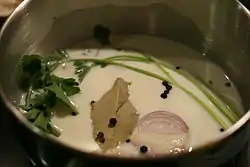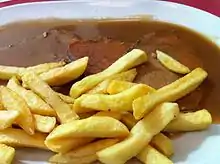French mother sauces
In French cuisine, the mother sauces (French: sauces mères), also known as grandes sauces or leading sauces, are a group of sauce recipes upon which many other sauces – "daughter sauces" or "small sauces" (French: petites sauces) – are based. There have been different classifications of mother sauces dating back to the 19th century.[1]
The most common group of mother sauces in current use is often attributed to chef Auguste Escoffier[2][3][4][5] as presented in the 1907 English-language edition of his seminal cookery book Le guide culinaire (A guide to modern cookery):[6]
- Béchamel sauce: White sauce, based on milk thickened with a white roux.
- Espagnole sauce: Brown sauce based on a brown stock reduction, and thickened with brown roux. Ingredients typically include roasted bones, bacon, and tomato (puréed and/or fresh).
- Tomato sauce (sometimes "Tomate" or "Tomat"): As well as tomatoes, ingredients typically include carrots, onion, garlic, butter, and flour, plus pork belly and veal broth.
- Velouté sauce: Clear sauce, made by reducing clear stock (made from un-roasted bones) and thickened with a white roux. Velouté is French for "velvety".
- Hollandaise sauce: Warm emulsion of egg yolk, melted butter, and lemon juice or vinegar.
The French editions of Le guide culinaire did not include Hollandaise as a grande sauce,[7] but separately described mayonnaise—a cold emulsion of egg yolks with oil and vinegar—as a mother sauce for cold sauces; this was not included in the English edition.
History
The concept of mother sauces predated Escoffier's classification by at least 50 years; in 1844, the French magazine Revue de Paris reported: "Oui ne savez-vous pas que la grande espagnole est une sauce-mère, dont toutes les autres préparations, telles que réductions, fonds de cuisson, jus, veloutés, essences, coulis, ne sont, à proprement parler, que des dérivés?" ("Don’t you know that the grand sauce Espagnole is a mother sauce, of which all the other preparations, such as reductions, stocks, jus, veloutés, essences, and coulis, are, strictly speaking, only derivatives?")[8]
Different classifications of French sauces into mother and daughter sauces have been proposed by different chefs, varying in number and selection.
Classification by Marie Antoine Carême
In 1833, Marie Antoine Carême published a classification of French sauces in his reference cookbook L’art de la cuisine française au XIXe siècle ("The Art of French Cuisine in the 19th Century"). Instead of mother sauces, he called them Grandes et Petites sauces ("great and small sauces").[9]
In this cookbook, Carême defined a sauce classification and listed four grandes sauces:
Carême classified the following as petites sauces:[9]
Classification by Jules Gouffé
In 1867 the French chef and pâtissier Jules Gouffé published Le livre de cuisine comprenant la grande cuisine et la cuisine de ménage (The Cookbook Including Grand And Domestic Cooking).[10]
In this book, Gouffé listed twelve mother sauces. (He used both the terms grandes sauces' and sauce mères).
- Espagnole Grasse (Fattier Espagnole)
- Espagnole Maigre (Leaner Espagnole)
- Velouté Gras (Fattier Velouté)
- Velouté Maigre (Leaner Velouté)
- Allemande (Velouté thickened with eggs)
- Béchamel à l’ancienne (Old Fashioned Béchamel)
- Béchamel de volaille (Poultry Béchamel)
- Béchamel maigre (Leaner Béchamel)
- Poivrade brune (Brown Poivrade)
- Poivrade Blanche (White Poivrade)
- Poivrade Maigre (Leaner Poivrade)
- Marinade
Classification by Auguste Escoffier
The pioneering chef Auguste Escoffier is credited with establishing the importance of Espagnole, Velouté, Béchamel and Tomate, as well as Hollandaise and Mayonnaise.[11][12] His book Le guide culinaire was published in 1903. The 1912 edition lists the "Grandes Sauces de base" as:[13]
- Espagnole
- Velouté
- Béchamel
- Tomate
Later in the text, he details these sauces and some variants:[14]
- Sauce Espagnole
- Sauce Espagnole maigre (leaner Espagnole sauce)
- Sauce Demi Glace (reduced Espagnole sauce)
- Jus de veau lié (reduced veal stock thickened with arrowroot)
- Velouté
- Velouté de volaille (poultry velouté)
- Velouté de poisson (fish velouté)
- Sauce Allemande (velouté thickened with eggs)
- Sauce suprême (velouté thickened with cream)
- Sauce Béchamel
- Sauce Tomate
Escoffier listed Hollandaise sauce as a daughter/small sauce in Le guide culinaire.[15] He placed mayonnaise in the chapter on cold sauces, and described it as a mother sauce for cold sauces, comparing it to Espagnole and Velouté.[16]
The 1907 abridged English edition of Le guide culinaire, A Guide to Modern Cookery, listed five "basic sauces", including Hollandaise alongside the existing four:[17]
- Espagnole
- Velouté
- Béchamel
- Tomato
- Hollandaise
A Guide to Modern Cookery detailed the preparation of these "leading sauces" and variations:[18]
- Brown Sauce or Espagnole
- Half Glaze
- Lenten Espagnole
- Ordinary Velouté Sauce
- Velouté de volaille
- Fish velouté
- Allemande sauce or thickened velouté
- Béchamel sauce
- Tomato Sauce
- Hollandaise Sauce
Instead of Escoffier's original list, "Jus de veau lié" and "Suprême sauce" were removed and "Hollandaise" was added. The English edition omitted the comments from the French edition that stated Escoffier considered mayonnaise to be a sort of mother sauce. Hollandaise is also absent from similar lists in Jules Gouffé's, Antoine Carême's, and Prosper Montagné’s cookbooks.
Sauces
Many sauces, often referred to as daughter sauces, can be derived from mother sauces.:[19][20]
Béchamel sauce
Béchamel is a milk-based sauce, thickened with a white roux and typically flavoured with onion, nutmeg or thyme.
Espagnole sauce
Espagnole is a strong-flavoured brown sauce, made from a dark brown roux and brown stock, usually beef or veal stock, and tomatoes or tomato paste.
Deivations of Espagnole
- Demi Glace
- Poivrade
- Grand veneur
- BigarradeBoajsnd
Velouté sauce
Velouté is a clear sauce, light in colour, made by reducing clear stock (made from un-roasted bones), usually veal, chicken or fish stock, thickened with a white or blond roux. Velouté is the French word for "velvety".
Derivations of Velouté
Tomato sauce
The sauce tomate described by Escoffier is a tomato sauce made with fatty salted pork breast, a mirepoix of carrots, onions and thyme, and white stock.
Derivations of Tomato
- Bolognaise
- Portugaise
- Milanaise
Hollandaise sauce
Hollandaise is a warm emulsion based on egg yolk, clarified butter, and flavoured with lemon juice or vinegar.
Derivations of Hollandaise
Mayonnaise
Mayonnaise is an emulsion of egg yolk and oil, served cold and flavoured with lemon juice, vinegar and seasoning.
References
- Carême, M. A. (Marie Antonin); Fayot, Charles Frédéric Alfred; Plumery, Armand; University of Leeds. Library (1833). L'art de la cuisine française au dix-neuviême siêcle : traité élémentaire et pratique ... University of Leeds Library. Paris : L'auteur [etc.]
- Lundberg, Donald E. (1965). Understand Cooking. Pennsylvania State University. p. 277.
- Allen, Gary (2019). Sauces Reconsidered: Après Escoffier. Rowman & Littlefield. p. 52.
- Ruhlman, Michael (2007). The Elements of Cooking: Translating the Chef's Craft for Every Kitchen. Simon and Schuster. p. 171.
- "Do You Know Your French Mother Sauces?". Kitchn. Archived from the original on 2020-11-12. Retrieved 2020-12-08.
- Escoffier, A. (Auguste); Escoffier, A. (Auguste); Herndon, James B.; Herndon/Vehling Collection. fmo (1907). A guide to modern cookery. Cornell University Library. London : W. Heinemann. p. 2.
- Escoffier, Auguste (1846-1935) Auteur du texte (1912). Le Guide Culinaire: aide-mémoire de cuisine pratique (3e édition) / par A. Escoffier ; avec la collaboration de MM. Philéas Gilbert et Émile Fétu. p. 3. Archived from the original on 2020-10-21. Retrieved 2020-12-08.
- "Revue de Paris". Gallica. May 1844. Archived from the original on 2019-10-25. Retrieved 2020-12-08.
- Carême, M. A. (Marie Antonin); Fayot, Charles Frédéric Alfred; Plumery, Armand; University of Leeds. Library (1833). L'art de la cuisine française au dix-neuviême siêcle: traité élémentaire et pratique ... University of Leeds Library. Paris : L'auteur [etc.]
- Gouffé, Jules (1807-1877) Auteur du texte (1867). Le livre de cuisine: comprenant la cuisine de ménage et la grande cuisine / par Jules Gouffé ; pl... dessinées... par E. Ronjat. Archived from the original on 2020-10-27. Retrieved 2020-12-08.
- Allen, Gary (2019). Sauces Reconsidered: Après Escoffier. Rowman & Littlefield. p. 52.
- Peterson, James (2017). Sauces: Classical and Contemporary Sauce Making, Fourth Edition. Houghton Mifflin Harcourt. p. 17. ISBN 9780544819832.
- Escoffier, Auguste (1846-1935) Auteur du texte (1912). Le Guide Culinaire: aide-mémoire de cuisine pratique (3e édition) / par A. Escoffier ; avec la collaboration de MM. Philéas Gilbert et Émile Fétu. p. 3. Archived from the original on 2020-10-21. Retrieved 2020-12-08.
- Escoffier, Auguste (1846-1935) Auteur du texte (1912). Le Guide Culinaire: aide-mémoire de cuisine pratique (3e édition) / par A. Escoffier ; avec la collaboration de MM. Philéas Gilbert et Émile Fétu. p. 13. Archived from the original on 2020-10-21. Retrieved 2020-12-08.
- Escoffier, Auguste (1846-1935) Auteur du texte (1912). Le Guide Culinaire: aide-mémoire de cuisine pratique (3e édition) / par A. Escoffier ; avec la collaboration de MM. Philéas Gilbert et Émile Fétu. p. 33. Archived from the original on 2020-10-21. Retrieved 2020-12-08.
- Escoffier, Auguste (1846-1935) Auteur du texte (1912). Le Guide Culinaire: aide-mémoire de cuisine pratique (3e édition) / par A. Escoffier ; avec la collaboration de MM. Philéas Gilbert et Émile Fétu. p. 48. Archived from the original on 2020-10-21. Retrieved 2020-12-08.
- Escoffier, A. (Auguste); Escoffier, A. (Auguste); Herndon, James B.; Herndon/Vehling Collection. fmo (1907). A guide to modern cookery. Cornell University Library. London : W. Heinemann. p. 2.
- Escoffier, A. (Auguste); Escoffier, A. (Auguste); Herndon, James B.; Herndon/Vehling Collection. fmo (1907). A guide to modern cookery. Cornell University Library. London : W. Heinemann. p. 18.
- "Mother and Daughter: the Extended Family of Sauces". www.finedininglovers.com. Archived from the original on 2020-10-24. Retrieved 2020-12-08.
- "Les sauces mères et leurs dérivés" (PDF). Archived (PDF) from the original on 2020-12-12. Retrieved 2020-12-08.


.jpg.webp)


.jpg.webp)